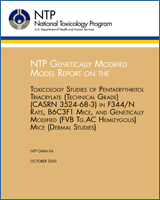
NTP Genetically Modified Model Report on the Toxicology Studies of Pentaerythritol Triacrylate (Technical Grade) (CASRN 3524-68-3) in F344/N Rats, B6C3F1 Mice, and Genetically Modified (FVB Tg.AC Hemizygous) Mice (Dermal Studies): NTP GMM 04 [Internet].
Chhabra RS, Mahler J, Bristol DW, et al.
Research Triangle Park (NC): National Toxicology Program; 2005 Oct.
Copyright Notice
This is a work of the US government and distributed under the terms of the Public Domain
NCBI Bookshelf. A service of the National Library of Medicine, National Institutes of Health.